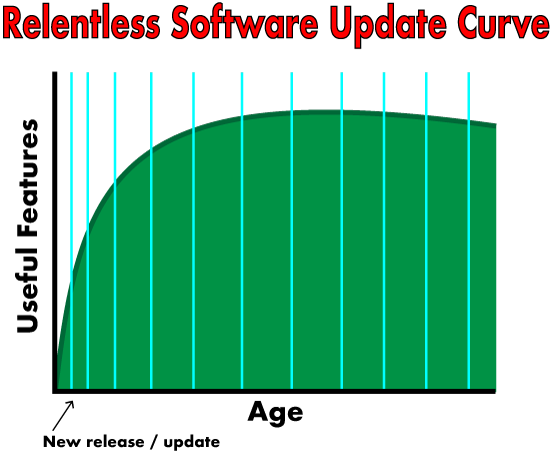I just suffered through another Mac OS X upgrade and the question lingers, “Why?” The OS has been pretty darn stable. I can understand security patches coming out monthly, which is how the Android OS updates. But a new major version of the OS, plus several minor updates throughout the year, is making me weary.
In Figure 1, I present what I call the Relentless Software Update Curve. It illustrates the number of useful features per upgrade over a span of time.

Figure 1. The Relentless Software Update Curve.
Initially, a software update offers new features and improves bugs. The new features are welcome improvements and updates, reflecting new hardware and other technologies as well as addressing user feedback and various inspiring innovations. This momentum, however, is unsustainable over time, which is what the curve attempts to illustrate.
As a historical example, MS-DOS was a bare-bones operating system. Version 2.0 offered high capacity (hard drive) storage support. Version 3.0 was a minor update. Version 4.0 was a disaster. Version 5.0, however, offered supplemental tools that really boosted the operating system’s capabilities. It was a huge leap on the feature side of the graph, making the update worthy, popular, and profitable for Microsoft.
As a parallel, the first few versions of Mac OS X offered incredible power and functionality to Apple’s Macintosh hardware platform. Annual updates continued to improve the software, offering amazing new features and “user experiences.”
About 8 years ago, with Mac OS X 10.6 “Snow Leopard,” innovation stalled. New features were added, but these were new features for the sake of new features or mobile OS features awkwardly stuffed into the desktop. OS X suddenly became clunky and awkward. Apple continued to shovel feature upon feature with subsequent releases of the operating system, burdening what was once a slick piece of software into a meddlesome, bloated beast. The curve illustrates how given enough time, the quantity of useful features decreases, either because they’re removed (where is FTP in OS X 10.13?) or they get pushed out by an abundance of questionably-useful new features.
Despite a lack of truly whiz-bang new features, Apple continues to plod ahead with annual OS X updates. I regret installing the last few. The reason is that the updates introduce instability into my workflow without adding something I need or want. The removal of the FTP command line utility, for example, pissed me off. I use FTP in various shell scripts. Hell, the Unix part of OS X is one reason I use a Mac and not a PC as my primary system. Now that Apple is messing with that core, it makes me want to find replacement hardware. As I’ve written before, as soon as Adobe publishes the Creative Suite for Linux, adios Apple!
Microsoft Office also suffers update bloat. The suite is stable and useful, yet another version looms in the future. My guess is that the new features will subtract from the user experience and overall usability, or they’ll be so negligible as to make many question why the need to update at all?

